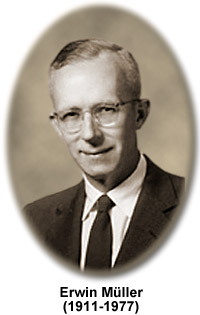Erwin Müller
(1911-1977)

Erwin Wilhelm Müller was a German-born physicist who invented both the field emission microscope and the field ion microscope, the latter of which enabled him to be the first person to ever observe individual atoms. Müller was educated at the Technical University in Berlin, where he studied under Nobel laureate Gustav Hertz. He obtained a degree in engineering in 1935 and his doctorate in 1936, but had problems trying to find a teaching post at a university for political reasons. In fact, it was not until after World War II, in 1950, that he received his habilitation from the Technical University in Berlin. Prior to that time, Müller carried out research at various institutions, including Siemens Research Laboratory, Stabilovolt Company, Kaiser-Wilhelm Institute for Physical Chemistry, the Technical University in Berlin, and the Free University of West Berlin. In 1952, Müller accepted a position at the Physics Department of Pennsylvania State University, and he and his family relocated to the United States.
Müller’s first major contribution to optics, the development of field emission microscopy, was made while he was still a graduate student working at Siemens, in 1936. Field emission is the emission of electrons from the surface of a conductor subjected to a high electric field. Müller used this phenomenon as the basis of a new type of microscope that enabled him to approach atomic resolution and which would have a profound effect on the study of solid surfaces. The field emission microscope is lens-less, instead consisting of, in its simplest form, a sample formed into a sharp, needle-like emitter and a fluorescent screen. When a field is applied to the emitter, electrons tunnel out of the emitter towards the screen, where the contrast occurs due to differences in the current densities of the electrons, revealing details about the sample’s surface.
Although the field emission microscope was a tremendous step forward in microscopy, Müller developed another innovative microscope in 1956 that greatly surpassed the capabilities of the earlier instrument. Dubbed the field ion microscope, this Müller invention, with a magnification of 1,000,000 or more and a resolution of 0.25 nanometers, made it possible for the first time to obtain clear images of individual atoms and their arrangement on the surface of a sample. Similar to the field emission microscope, the field ion microscope consists of a sample in the shape of a pointed tip and a fluorescent screen, but unlike the other device, requires the presence of an imaging gas, such as hydrogen or helium, in a vacuum chamber before an electric field is applied to the tip, which is also located in the chamber. Atoms of the gas adsorbed on the tip once positive voltage is applied are ionized and are repelled towards the fluorescent screen, effectively imaging the surface of the tip. Through such means, Müller became the first person ever to “see” atoms.
In 1967, Müller invented yet another important scientific instrument, which he referred to as an atom probe, but later came to be more widely known as the atom probe field ion microscope. As suggested by its more common moniker, the instrument is based on field ion microscopy, but also involves a drift tube that ejected atoms travel down in order that the time of their arrival may be measured. This measurement can then be used to determine the mass of particular atoms, providing a highly useful means of compositional analysis. Along with Müller’s other inventions, the atom probe field ion microscope represented a significant advance in the field of materials science.
In recognition for his numerous achievements, Müller received many awards and honors. Among them are the Achievement Award of the Instrument Society of America (1960), the prestigious John Scott Medal presented by the City of Philadelphia (1970), and the American Physical Society’s Davisson-Germer Prize (1972). In 1976, Müller was also to receive the National Medal of Science, but due to a postponement of the ceremony, his daughter, Jutta, was obliged to accept it for him posthumously from President Jimmy Carter on November 22, 1977.
